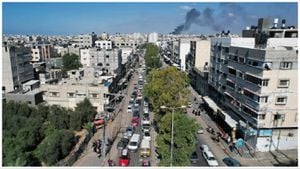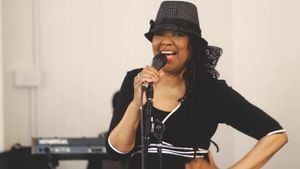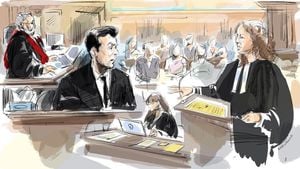Marching for Truth and Reconciliation Unites Montreal
On September 30, 2023, hundreds of Montrealers gathered for the fourth annual Every Child Matters march, honoring the survivors and victims of Canada's residential school system. Starting at Mount Royal Park, participants marched toward Place Ville Marie, chanting powerful slogans like "Land back" and "No pride in genocide." Their voices echoed the urgency of recognizing the deep scars left by historical injustices faced by Indigenous Peoples.
Selena Martineau, one of the protestors and an employee at Resilience Montreal—a local shelter for the unhoused—emphasized the march's significance, stating, “The importance of this march is to honor the Survivors of residential schools and how they impacted the Indigenous population. We are here to uplift them as much as possible and honor what they’ve gone through.” This sentiment of remembrance and solidarity ran throughout the day's events, highlighting the need for healing within and across communities.
The march occurred on the same day as the national holiday, recognizing the legacy of the Truth and Reconciliation Commission's work, aiming to educate Canadians about historical wrongdoings and engage them actively in reconciliation efforts. Participants held signs reflecting their messages, with many wearing orange shirts, symbolizing support for the movement and respect for the victims.
This demonstration was part of broader events taking place across Canada, meant to raise awareness about the continued struggles faced by Indigenous communities today. When considering the aftermath of colonialism, it’s clear these struggles don't just rest on historical injustices but are also interwoven with present-day policies and societal dynamics. Acknowledgment is the first step toward healing—as expressed by Muskrat’s rising star, who emphasized, ”When we engage and listen, we build pathways to restoration.”
Louise Bernice Halfe's Reflection on Reconciliation
Adding to the conversations around reconciliation, Louise Bernice Halfe, also known by her Cree name, Sky Walker, participated as the guest speaker at Humboldt’s annual Truth and Reconciliation Walk on September 29, 2024. Halfe carries with her the weight of experience as both a residential school survivor and as someone who has navigated the complex landscapes between Indigenous and non-Indigenous worlds. Her poetry reflects these dualities, teaching about the significance of dialogue and connection.
During her address, Halfe eloquently depicted her life experiences, from residing at residential school to her marriage with a white physician—providing her unique insights on race and class. “I don't like the term ‘building bridges’ because it implies I am going to walk over you,” she said. “It’s about dialogue, and sometimes dialogue is very difficult.” Through this lens, she highlights the need for patience and openness, keys to unlocking difficult conversations and fostering real connections.
By elaborately defining the term "reconciliation," Halfe pointed out its roots lie in establishing peace among differing communities through shared experiences and understandings. She described her commitment to sharing Indigenous knowledge and traditions as fundamental aspects of her work, and her poetry serves to highlight the healing required to address the wounds of colonialism.
Halfe also noted the tangible struggles Indigenous peoples face, which are often overshadowed by narratives focusing on the romanticized aspects of settler history. These narratives, she argues, neglect the deeply entrenched disparities, as remnants of colonization still vibrate through modern legislative structures affecting Indigenous lives today. Her call to action was clear: artists, storytellers, and communities must help shape the narrative, acknowledging truth to activate healing.
Indigenous Art as Dialogue for Reconciliation
Highlighting the role of art within these important dialogues, the Union Gallery recently showcased its third annual Indigenous Art Exhibition, running from September 23 to October 12. This exhibit is pivotal as it offers local Indigenous artists like Candice Martin, Jamaica Cass, and Chayse Davey, the platform to present their perspectives through various art forms, fostering education and connection between Indigenous and non-Indigenous attendees. The pieces range from paintings to beadwork and serve as conduits for discussions on the impacts of colonization, identity, and reconciliation.
Artist Taylor Tye’s works, for example, manipulate language and imagery deeply rooted within matriarchal Anishinaabe traditions. Her lino-print titled, “We Gather in this Place of Clay,” is both a land acknowledgment and invitation for viewers to reflect upon the significance of place. “Art is such a great communication tool because it’s open for interpretation,” Tye commented. “It’s one thing to be told how to think, what to say, and how to act, but I don’t think that's the most effective way of communicating how our relationships should look and take shape.”
Another featured artist, Carleigh Candice Mignonne Milburn, discussed the importance of incorporating traditional language and storytelling within her artworks. She expressed how these elements can bridge divides and lead to more meaningful interactions about culture and reconciliation. Her contributions to the exhibition include vibrant pieces depicting strawberries and flowers, which symbolize connections among various peoples and cultures, showcasing shared experiences stemming from diverse backgrounds.
Milburn articulated, “It’s our responsibility to make sense of what these calls to action may look like and to educate those who may not understand.” With these fleeting yet impactful representations, Indigenous artists remind onlookers of the emotional and historical weight carried within each brushstroke and bead.
Art, Activism, and Community Engagement
Artistic expression has become integral to Indigenous activism, allowing communities to amplify their voices and share their stories. Not only do these artistic movements serve as dynamic tools for education, but they also unite generations of Indigenous peoples, fostering solidarity among various community groups. This cross-pollination of ideas and styles has led to powerful conversations about identity, trauma, resilience, and, most prominently, pathways to reconciliation.
Recent exhibitions and community engagements highlight the necessity of creating safe spaces for dialogue. Gallery walks, workshops, and activist forums have emerged as conduits for more significant conversations surrounding the realities of residential schools, the historical displacement of Indigenous peoples, and contemporary issues like land rights and sovereignty.
Through grassroots initiatives, artists and activists are working together to push these conversations to the forefront of public consciousness, asking society to not only listen but engage actively with the histories and narratives presented. Such initiatives could shape policies and perceptions, striving to dismantle systemic inequities ingrained within societal structures.
Solidarity Through Activism and EducationToday, as Canada continues to navigate its complex relationship with Indigenous communities, events like marches for truth and reconciliation and exhibitions of Indigenous art play pivotal roles. These efforts are not merely about acknowledgment but instill hope for genuine reparative processes and community healing.
Artists like Louise Bernice Halfe, through their storytelling, etch important reminders of the resilience and strength within Indigenous cultures. They challenge audiences to reflect on their roles within this narrative and spur action toward fostering reconciliation. By amplifying Indigenous voices—whether through poetry, visual arts, or public discourse—the country can move closer to establishing more equitable relationships among its Indigenous and non-Indigenous populations.
The path to truth and reconciliation is laden with trials and tribulations, but the unity echoed within marches and the artistry speaking volumes through exhibits signify the potential for meaningful transformation. Canadians must collectively recognize the past and embrace collaborative efforts toward healing and justice as they stride forward toward reconciliation.



